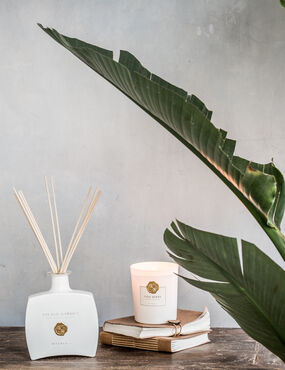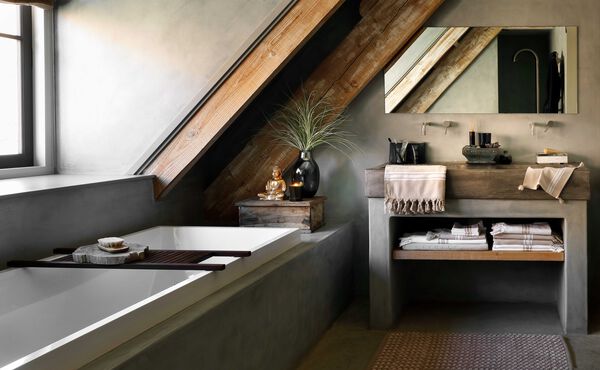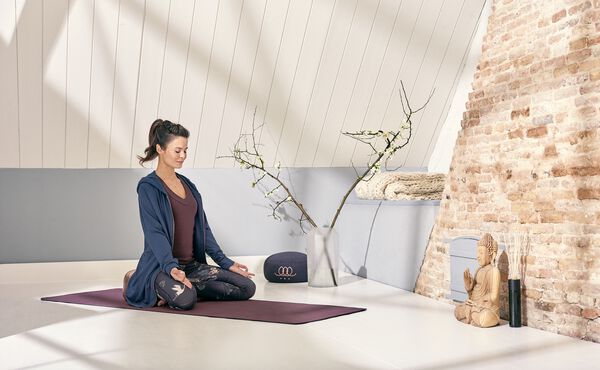Meditation studios and mindfulness retreats can be found just about anywhere, from a remote hilltop in the Himalayas to your local gym. But rather than booking a cushion at a meditation venue, why not create your own meditation sanctuary at home? Here are some tips to help you craft the perfect at-home meditation retreat.
Going to a meditation class can be a great way for beginning meditators to learn different techniques from an experienced teacher. But taking classes requires a substantial investment of time and money, which can make it difficult to commit to a daily meditation class that fits your schedule and budget. Since meditation is best practiced every day, having a self-practice at home is key if you want to enjoy health benefits such as reduced stress levels, a strengthened immune system, and improved happiness.
In the comfort of your own home
At Rituals, we’ve long emphasised the benefits of creating a meditation space in your house. It allows you to build on what you’ve learned in class and, more importantly, it provides a place where you can unplug and find stillness at any time in the comfort and convenience of your own home.
You may feel a little daunted by the idea of creating an at-home meditation retreat – how do you pick the right place, how do you create a calm and soothing ambiance, and how will you know what to do without the guidance of a teacher? To help you on your way, we’ve put together a list of simple things you can do to create your own mediation space, and we offer guided meditations that can be accessed from your mobile device anytime and anywhere. For all the details on how to craft the perfect meditation sanctuary inside your home, here are some more in-depth tips.
1. Pick a space that’s light, quiet and private
You don’t need a big house to create a meditation space. A corner of a room, a window seat, a tiny attic sanctuary, a balcony, a hallway, or even a spacious closet will do. The crucial thing is that you pick a spot where you feel at peace and at ease.
There are some additional things you may want to consider when designating a meditation space. First of all, it’s best to pick a spot with lots of natural light. Natural light has a powerful effect on the body and mind – it elevates your mood and gives you a sense of warmth and tranquillity. Secondly, choose a quiet area in your house and avoid a room that shares a wall with a loud neighbour or a noisy street. If noise in unavoidable, you can add a water fountain to your meditation space. The sound of trickling water will have a relaxing and soothing effect. Thirdly, your meditation space should be a private and away from distraction. Pick a spot where you know you won’t be disturbed mid-meditation by members of your household or their activities.
2. Get a plant
In any meditation sanctuary, natural elements are essential. Decorate your space with stones, seashells, a water feature and – especially – plants. Breathing is a fundamental part of meditation, and plants make for great air purifiers. In fact, a well-known NASA study showed that certain houseplants are highly effective pollutant-removers, and that a single plant can pull all toxins from the air in a room of 10 square metres. To create a natural vibe and to optimise the air quality in your meditation space, make sure you add one or two NASA-approved plants, such as a bamboo palm, a snake plant or a peace lily.

3. Engage your senses
Meditation is about becoming fully engaged with the present moment, which involves all our senses. Smell is one of our most primitive and powerful senses. That’s why scents – in the form of scented candles, oils or incense – can profoundly enhance your meditation session. Although you can use any scent that makes you feel relaxed, the scents of sandalwood, bamboo, lavender, sage and peppermint are known to encourage a meditative state. Try adding one of these fragrances to your meditation practice to see how it can enhance your experience.
Other senses – such as touch, hearing and sight – can also help bring you to the present moment. Choose soft textures, soothing sounds and light shades for your meditation space. You may even want to keep a piece of chocolate in your meditation sanctuary, so you can meditate on the rich sensations it triggers as it’s melting on your tongue.
4. Consider meditation furniture
If you want to start meditating, there’s no need to get the ‘right’ equipment. All you really need for a meditation session is your body, a place to sit, and a minute or two. That said, you shouldn’t force yourself to sit cross-legged on the floor if it causes you pain or discomfort. If you need some extra support, it can be a good idea to use a meditation cushion, a meditation chair or a bench. You can also decorate your meditation space with a low meditation table and some pillows, which is perfect for seated contemplation or a tea break.
When it comes to meditation cushions, the two most popular types are the zafu and the zabuton. A zafu is a round cushion, which lifts your hips off the ground and provides your knees with support as you sit in a cross-legged posture. A zabuton is a rectangular mat, which is larger and flatter than a zafu. The two are often sold in sets, so that meditators can place their zafu on top of their zabuton for optimal comfort and support. If you have difficulty meditating with your legs crossed, you should try a meditation bench. A bench assists you when meditating in the traditional Japanese kneeling position called seiza. Another possibility is a meditation chair, which offers maximum support as it has both a seat cushion and a back cushion. Available in all styles and sizes, meditation chairs make comfortable additions to your sanctuary.
5. Decorate with intent
Your meditation space is your haven, so it should reflect your personality and preferences. You want it to be a place of comfort where you feel happy and serene, but it can be a challenge to bring more personality into your meditation sanctuary without cluttering up the space with too much decoration. That’s why it’s so important to decorate your meditation space with intent. Be mindful about more than functionality or design. To really turn your space into a personal sanctuary, pay attention to the textures, colours, scents, and the overall feel of each and every piece you add to your sacred space.



.jpg?sw=600&sh=370&sm=fit&cx=240&cy=160&cw=1782&ch=1099&sfrm=jpg)
.jpg?sw=600&sh=370&sm=fit&cx=0&cy=0&cw=5760&ch=3552&sfrm=jpg)

